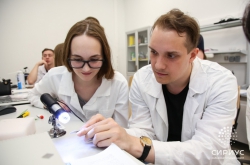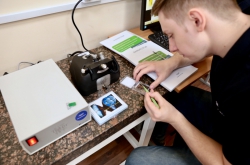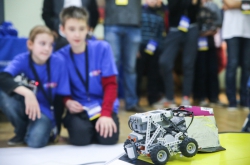It was back last year that ITMO University became a tutor for the Agency for Strategic Initiatives’ program on creating a new model for extracurricular education for children. Since then, it has been actively participating in the development of “nanoquantums” for the new “quantorium” children’s technoparks. The university is now responsible for designing educational programs for new federal projects on extracurricular education, training tutors who will work at quantoriums, as well as developing and producing specialized equipment for the new project on the base of its Technopark.
“Here at ITMO University, we started to develop nanotechnologies even before they became popular. At first, we were doing that on the base of the Department of Nanotechnologies and Materials Science, and now we are doing it as part of the Faculty of Physics and Engineering. 15 years ago, we launched our company, NT-SPb (Nanotechnologies St. Petersburg), that has been resident of ITMO’s Technopark for 10 years already, and develops different types of scanning probe microscopes in collaboration with the LMT company, another Technopark resident. These devices that are amongst the basic instruments used in modern nanotechnology have been long used by ITMO University. From the very beginning, this equipment has been applied for not just the purposes of research, but for educational purposes, as well, which allowed us to accumulate the extensive experience that we used to develop the NanoEducator kit. Now, it’s used at many universities and even at schools. Naturally, having tested our invention, we continue to develop the project; as of now, we produce it under the brand Nano Tutor. Not so long ago, the Sirius educational center was launched, where they also have the nanotechnology track, and then the quantorium technoparks started to appear throughout the country. Soon, it turned out that our equipment, as well as the very concept of Nano Tutor is great for the tasks they solve at Sirius and children’s technoparks,” explains Aleksander Golubok.

As of now, more than 500 pieces of this equipment are used throughout Russia. The company has also made sales in the Netherlands and Italy; last year, NT-SPb won a tender on equipping five quantoriums in different regions - Skolkovo, Korolev, Ryazan, Rybinsk and Penza, and has recently completed these School Laboratories for Nanotechnology.
The company relied on its experience of working with educational establishments to develop devices that are suited for various tasks and can be used by both school and university students. The general idea was to create high-tech equipment that will be safe to work with, so that school students will get the opportunity to try working on it singlehandedly and “feel” the nanoscale world.
“Equipment used in nanotechnology is usually complex, expensive, and sometimes unsafe. In contrast, we’ve set the goal to make such equipment that won’t require expensive supplies and that school students would be able to use on a daily basis. We call this approach “step by step into the nano-world”, as it indeed shapes an entirely different outlook. Some 15 years ago, a specialist with a major in engineering wouldn’t have believed what even a school student can now understand. Therefore, today’s freshmen should know that one can operate inside a micron and even on the atomic scale. Technologies now develop at such a pace that we have to teach them not what is already known, but what will soon be discovered,” comments Aleksander Golubok.
High School Laboratories for Nanotechnology
High School Laboratories for Nanotechnology are organized as a unified system where every element serves a common purpose. The complete set offers a wide range of equipment for conducting interdisciplinary research: the NanoTutor scanning probe microscope fixed with both silicon cantilever probes and tungsten probes and a device for producing them, an optical microscope with the MicProbe SPM unit, the ProBeam device which is a tabletop electron microscope combined with an SPM unit, x-ray fluorescent spectrometer, educational software and some test samples. All of that is totally safe for use, what is more, the equipment doesn’t require any expensive materials.

“At FabLabs, they also have sets of different equipment: 3D printers, laser engravers, and other devices. All of those are instruments for conducting “big” projects. When we were working on the high school laboratories for nanotechnologies, we followed the same concept, so our laboratories are like nano-fablabs, where you can use a set of equipment to complete a particular project,” shares Ivan Mukhin.
Possible applications
The set has a wide range of applications. First of all, the students can use the equipment to understand how the world works on the simplest examples. Why lotus petals don’t absorb moisture? What does a butterfly’s color depend on? What is the structure of a human hair? These are just few of the questions they’ll be able to answer having started to study nanotechnologies.
The schoolchildren will also be able to observe how the fundamental laws of physics work. For instance, they’ll see how the quantum tunneling effect is used in a tunneling microscope, learn to measure miniscule force with the help of Hooke’s law, a laser, a photodiode and an optical lever, understand how an electrochemical reaction can help manufacture an ultrasharp needle, or how can a computer be used to enhance a noised image, as well as many other things. This way, the students will see how things they’ve learned from their lessons in physics, mathematics, chemistry and computer science “come into life”, stresses Aleksander Golubok. On the other hand, the capabilities of the laboratory are not limited to just some particular field of science, so the students can work on solving problems from different fields at the same time.

Many of the tasks for the high school laboratories can come from research centers and industrial partners. A good example is a project on information protection. Some students have already offered a solution where nanotechnologies are used to protect documents from being counterfeited; they propose to create unique watermarks that are almost impossible to forge, yet are easy to use and can be seen with a common optical microscope.
By participating in the work of high school laboratories, the students get a wide range of skills that are essential for conducting research: they learn to work with high-tech equipment, make use of scientific data and do computer modeling.
Virtually, school laboratories can teach students starting with their fifth year, explains Ivan Mukhin. At this age, children can already conduct simple laboratory work, and thus gradually create the groundwork for their future education.
Yet, it is the high school students who get the most involved in the laboratories’ work, as they’ve already got the basic course in physics, chemistry and mathematics. They can already conduct projects of their own and reinterpret the given tasks. The proper work of mentors is very important here, as they should both provide their students with additional knowledge and give them the freedom necessary to approach the projects in a creative manner.

Mentors
ITMO University also partakes in training mentors for the regional high school laboratories. The training courses are conducted twice a year at the Engineering Center and the “Nanoclassroom” that has recently been launched at the Faculty of Physics and Engineering. Mentors attend lectures and workshops where they learn to work with equipment, conduct project activities and effectively communicate with school students. What is more, the training is conducted with regard to the peculiarities of working in each region. For instance, some of the quantoriums collaborate with universities and enterprises, so they aim to consider their partner’s requests in their project work. Also, ITMO regularly conducts webinars where mentors from different regions can get answers to any questions that arise during their work.
According to Aleksander Golubok, they are also considering launching special Master’s program for mentors in the future.
“To have a broader look at the issue, we have to make clear who mentors at quantoriums are. In terms of the former educational system, they are handicraft teachers. Yet, they have to know physics, chemistry, biology, computer science, engineering, and be able to conduct project activities. We can train such specialists on two-year Master programs, the ideal candidates being Bachelor’s students who got their major in technical sciences. A similar approach is already used for training FabLab teachers. Thus, in future we should aim to organize the training of mentors for quantoriums on the base of specialized Master’s program in particular,” concludes the professor.
We’d like to note that by the end of 2018, the Agency for Strategic Initiatives plans to open quantoriums in 25 more regions. Thus, the network of children’s technoparks in Russia will include 80 facilities in 61 regions.





